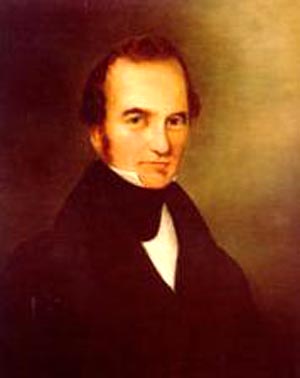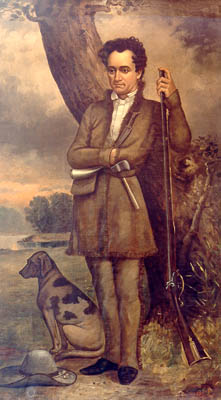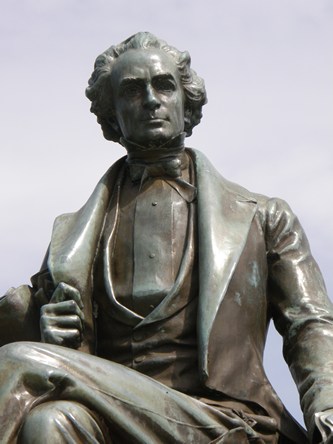<Back to Index>
- Explorer and Father of Texas Stephen Fuller Austin, 1793
- Painter Annibale Carracci, 1560
- Meiji Emperor of Japan Mutsuhito, 1852
PAGE SPONSOR



Stephen Fuller Austin (November 3, 1793 – December 27, 1836), known as the Father of Texas, led the second and ultimately successful colonization of the region by bringing 300 families from the United States. The capital of Texas, Austin in Travis County, Austin County, Austin Bayou, Stephen F. Austin State University in Nacogdoches, Austin College in Sherman, as well as a number of K-12 schools are named in his honor.
Stephen F. Austin was born in the mining regions of southwestern Virginia (Wythe County), in what is now known as Austinville, some 250 miles (400 km) southwest of Richmond, Virginia. He was the second child of Moses Austin and Mary Brown Austin, the first, Eliza Austin, having lived only one month. On June 8, 1798, when he was four years old, his family moved forty miles west of the Mississippi River to the lead mining region in present-day Missouri. His father Moses Austin received a Sitio from the Spanish government for the mining site of Mine á Breton. When Austin was eleven years old, his family sent him to be educated at Bacon Academy in Colchester, Connecticut, and then at Transylvania University in Lexington, Kentucky, from which he graduated in 1810. After graduating in Kentucky, Austin began studying to be a lawyer, at age twenty-one he served in the legislature of the Missouri Territory. As a member of the territorial legislature, he was "influential in obtaining a charter for the struggling Bank of St. Louis."
Austin was left penniless after the Panic of 1819, and decided to move south to the new Arkansas Territory. He acquired property on the south bank of the Arkansas River, in the area that would later become Little Rock. After purchasing the property he learned that the area was in consideration as the location for the new territorial capital, which could make his land worth a great deal more.
He made his home in Hempstead County, Arkansas,
before moving to the Texas territories. Two weeks before the first
territorial elections in 1820, Austin declared his candidacy for
Congress. His late entrance meant that his name did not appear on the
ballot in two of the five counties, but he still placed second in the
field of six candidates. He was later named a judge for the First
Circuit Court. Over
the next few months, Little Rock did become the territorial capital,
but Austin's claim to land in the area was contested and the courts
ruled against him. The Territorial Assembly also reorganized the
government, abolishing Austin's judgeship. Austin then moved to Louisiana. He reached New Orleans in November 1820, where he met and stayed with New Orleans lawyer and former Kentucky congressman Joseph H. Hawkins and made arrangement to study law. During Austin's time in Arkansas, his father had traveled to Spanish Texas and received an empresarial grant that would allow him to bring 300 Americans to Texas (they would later become known as The Old 300). Moses Austin was attacked on his way back to Missouri. Upon
returning home Moses became ill with what was believed to be pneumonia
and died on June 10, 1821. He left his empresario grant to his son,
Stephen. Though Austin was reluctant to carry on his father's Texas
venture, Austin was ultimately persuaded to pursue the colonization of
Texas by a letter from his own mother, Mary Brown Austin, written just two days before Moses Austin died. Austin had boarded the steamer Beaver and departed to New Orleans to meet Spanish officials led by Erasmo Seguín. He was at Natchitoches, Louisiana,
on June 31, 1821, when he learned of his father's death. "This news has
effected me very much, he was one of the most feeling and affectionate
Fathers that ever lived. His faults I now say, and always have, were
not of the heart." His
party traveled the 300 miles (480 km) in three weeks to San
Antonio with the intent of reauthorizing his father's grant, arriving
on August 12. While in transit, they learned that Mexico had declared
its independence from Spain, and Texas had become a Mexican province
rather than a Spanish territory. In San Antonio, the grant was
reauthorized by Governor Antonio María Martínez, who allowed Austin to explore the Gulf Coast between San Antonio and the Brazos River in order to find a suitable location for a colony. As guides for the party, Manuel Becerra, along with three Aranama Indians, went with the expedition. Austin advertised the opportunity in New Orleans, stating that the land was available along the Brazos and Colorado rivers. A
family of a husband, wife and two children would receive 1,280 acres (520 ha) at twelve and a half cents per acre.
Farmers could get 177 acres (0.72 km2)
and ranchers 4,428. In December 1821, the first U.S. colonists crossed
into the granted territory by land and sea, on the Brazos River in
present day Brazoria County, Texas. Austin's plan for a colony was thrown into turmoil by the independence of Mexico from Spain in 1821. Governor Martínez informed Austin that the junta instituyente, the new rump congress of the government of Agustín I of Mexico, refused to recognize the land grant authorized by Spain, based on a new policy of using a general immigration law to regulate new settlement in Mexico. Austin traveled to Mexico City and managed to persuade the junta instituyente to
authorize the grant to his father, as well as the Law signed by the
Spanish Emperor on January 3, 1823. The old Imperial Law offered heads
of families a league and a labor of land, 4,605 acres
(19 km²), and other inducements. It also provided for the
employment of agents, called empresarios, to promote immigration.
As empresario, Austin himself was to receive 67,000 acres
(270 km²) of land for each two hundred families he
introduced. According to the law, immigrants were not required to pay
fees to the government. This fact soon led some of the immigrants to
deny Austin's right to charge them for services at the rate of
12½ cents an acre ($31/km²). When the Emperor of Mexico, Agustín de Iturbide, abdicated in March 1823,
the law was annulled once again. In April 1823, Austin induced the
congress to grant him a contract to bring 300 families into Texas. He
wanted honest, hard-working, people who would make the colony a huge
success. In 1824 the congress passed a new immigration law that allowed
the individual states of Mexico to administer public lands and open
them to settlement under certain conditions. In March 1825 the
legislature of the Mexican state of Coahuila y Tejas passed
a law that was similar to the one authorized by Iturbide. The law
continued the system of empresarios, as well as granting each married
man a league of land, 4,428 acres (18 km²), with the
stipulation that he must pay the state thirty dollars within six years. By late 1825, Austin had brought the first 300 families to his settlement (The Austin Colony), now known in Texas history as the Old Three Hundred,
to the grant. Austin had obtained further contracts to settle an
additional 900 families between 1825 and 1829. He had effective civil
and military authority over the settlers,
but he was quick to introduce a semblance of American law - the
Constitution of Coahuila y Tejas was agreed on in November 1827. Also,
Austin organized small, informal armed groups to protect the colonists,
which evolved into the Texas Rangers. Despite his hopes Austin was making little money from his endeavors; the colonists were unwilling to pay for his services as empresario and most of the money gained was spent on the processes of government and other public services. It was during these years that Austin, a member of Louisiana Lodge No. 111 at Ste. Genevieve, Missouri, sought to establish Freemasonry in
Texas. Freemasonry was well established among the educated classes of
Mexican society. It had been introduced among the aristocracy loyal to
the House of Bourbon, and the conservatives had total control over the Order. By 1827 Americans living in Mexico City had introduced the American York Rite of Freemasonry as a liberal alternative to the established European-style Scottish Rite. On February 11, 1828, Austin called a meeting of Freemasons at San Felipe for the purpose of electing officers and petitioning the Masonic Grand Lodge in Mexico City for a charter to form a lodge. Austin was elected Worshipful Master of the new lodge. Although the petition reached Matamoros,
and was to be forwarded to Mexico City, nothing more was heard of it.
By 1828, the ruling faction in Mexico was afraid that the liberal
elements in Texas might try to gain their independence. Fully aware of
the political philosophies of American Freemasons, the Mexican government outlawed
Freemasonry on October 25, 1828. In 1829, Austin called another meeting
where it was decided that it was "impolitic and imprudent, at this
time, to form Masonic lodges in Texas." He was active to promote trade and to secure the good favor of the Mexican authorities, aiding them in the suppression of the Fredonian Rebellion of Haden Edwards.
However, with the colonists numbering over 11,000 by 1832 they were
becoming less conducive to Austin's cautious leadership, and the
Mexican government was also becoming less cooperative - concerned with
the growth of the colony and the efforts of the U.S. government to buy
the state from them. The Mexican government had attempted to stop
further U.S. immigration as early as April 1830, but again the skills
of Austin had gained an exemption for his colonies. He gave
640 acres (2.6 km2) to the husband, 320 to the wife, 160 for every child, and 80 for every slave.
The application of the immigration control and the introduction of tariff laws had done much to dissatisfy the colonists, peaking in the Anahuac Disturbances. Austin then felt compelled to involve himself in Mexican politics, supporting the upstart Antonio López de Santa Anna. Following the success of Santa Anna, the colonists sought a compensatory reward, proclaimed at the Convention of 1832 — resumption
of immigration, tariff exemption, separation from Coahuila, and a new
state government for Texas. Austin was not in favor of these demands,
he considered them ill-timed and tried his hardest to moderate them.
When they were repeated and extended at the Convention of 1833, Austin traveled to Mexico City on July 18, 1833, and met with Vice President Valentín Gomez Farías.
Austin did gain certain important reforms; the immigration ban was
lifted, but not a separate state government. Separate statehood
required a population of 80,000 before it could be granted, and Texas
had only 30,000.
In
his absence, a number of events propelled the colonists toward
confrontation with Santa Anna's centralist government. Austin took
temporary command of the Texan forces during the Siege of Bexar from October 12 to December 11, 1835. After learning of the Disturbances at Anahuac and
Velasco in the summer of 1835, an enraged Santa Anna made rapid
preparations for the Mexican army to sweep Anglo settlers from Texas.
War began in earnest in October 1835 at Gonzales. The Republic of Texas,
created by a new constitution on March 2, 1836, won independence
following a string of defeats with the dramatic turnabout victory at the Battle of San Jacinto on April 21, 1836, and the capture of Santa Anna the following morning. In December 1835 Austin, Branch Archer and William H. Wharton were
appointed commissioners to the U.S. by the provisional government of
the republic. On June 10, 1836, Austin was in New Orleans when he
received word of Santa Anna's defeat by Sam Houston at
San Jacinto. Austin returned to Texas to rest at Peach Point in August.
On August 4, he announced his candidacy for president of Texas. Austin
felt confident he could win the election until with two weeks before
the election, on August 20, Houston entered the race. Austin wrote,
"Many of the old settlers who are too blind to see or understand their
interest will vote for him." Houston carried East Texas, the Red River
and most of the soldier vote. Austin polled 587 votes to Sam Houston's 5,119 and Henry Smith's 743 votes. Houston
would appoint Austin as the first Secretary of State of the new
Republic; however, Austin had served only around 2 months before his
death. In
December 1836, Austin was in the new capital of Columbia (now known as
West Columbia) where he caught a severe cold; his condition worsened.
Doctors were called in, but could not help him. Austin died of pneumonia at
noon on December 27, 1836, at the home of George B. McKinstry right
outside of what is now West Columbia, Texas. Austin's last words were
"The independence of Texas is recognized! Don't you see it in the
papers?..." Upon hearing of Austin's death, Houston ordered an official
statement proclaiming: "The Father of Texas is no more; the first
pioneer of the wilderness has departed." Austin was originally buried at Gulf Prairie Cemetery in Brazoria County, Texas. Austin's body was moved, however, in 1910 to the Texas State Cemetery in Austin, Texas. Austin died without having produced offspring, and bequeathed all his land, titles, and possessions, to his sister, Emily Austin Perry.